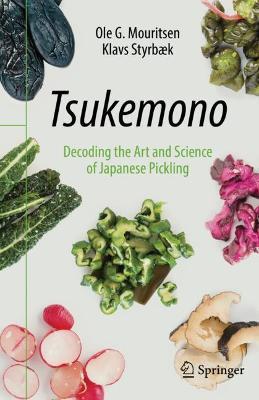Tsukemono: Decoding the Art and Science of Japanese Pickling

Tsukemono: Decoding the Art and Science of Japanese Pickling
Preface: Pickling and tsukemono-a culinary tradition worth preserving
1. Vegetables and tsukemono-made for each otherMaking vegetables more palatableThe taste and smell of 'home'Tradition and renewal
2. The many varieties of tsukemonoA little bit of tsukemono historyTen ways to prepare tsukemono
3. Salt, taste, mouthfeel, and colorSalt is the keyTaste and mouthfeelThe color of tsukemonoSpices and other taste enhancers
4. Techniques and methodsThe physical structure of vegetablesIt is all about reducing water contentDehydrationThe pickling crocksBriningPicklingBook proposal: Tsukemono: A Culinary Tradition Worth Preserving 4Marinating in soy sauce, miso, and sake leesFermenting and yeastingFermented vegetables in other food culturesPickled cucumbers
5. Tsukemono for everyoneCucumbersAsparagusJerusalem artichokesBroccoliKohlrabiDaikon, carrots, and "vegetable pasta"Radishes and turnipsChinese cabbage and lacinato kaleGarlicSquashDanish open-faced sandwichesPlumsFlowers
6. Tsukemono in Japan"Preserving the Japanese Way" at homePickled foods made in factories, both large and smallBuying tsukemono at the market and in shops
7. Tsukemono, nutrition, and wellnessSlightly sour, a little tartVitamin contentDesirable bacteria, fungi, and enzymesBeneficial effects of fermentationGo easy on the saltEat tsukemono in moderation
PRP: 209.92 Lei
Acesta este Prețul Recomandat de Producător. Prețul de vânzare al produsului este afișat mai jos.
167.94Lei
167.94Lei
209.92 LeiLivrare in 2-4 saptamani
Descrierea produsului
Preface: Pickling and tsukemono-a culinary tradition worth preserving
1. Vegetables and tsukemono-made for each otherMaking vegetables more palatableThe taste and smell of 'home'Tradition and renewal
2. The many varieties of tsukemonoA little bit of tsukemono historyTen ways to prepare tsukemono
3. Salt, taste, mouthfeel, and colorSalt is the keyTaste and mouthfeelThe color of tsukemonoSpices and other taste enhancers
4. Techniques and methodsThe physical structure of vegetablesIt is all about reducing water contentDehydrationThe pickling crocksBriningPicklingBook proposal: Tsukemono: A Culinary Tradition Worth Preserving 4Marinating in soy sauce, miso, and sake leesFermenting and yeastingFermented vegetables in other food culturesPickled cucumbers
5. Tsukemono for everyoneCucumbersAsparagusJerusalem artichokesBroccoliKohlrabiDaikon, carrots, and "vegetable pasta"Radishes and turnipsChinese cabbage and lacinato kaleGarlicSquashDanish open-faced sandwichesPlumsFlowers
6. Tsukemono in Japan"Preserving the Japanese Way" at homePickled foods made in factories, both large and smallBuying tsukemono at the market and in shops
7. Tsukemono, nutrition, and wellnessSlightly sour, a little tartVitamin contentDesirable bacteria, fungi, and enzymesBeneficial effects of fermentationGo easy on the saltEat tsukemono in moderation
Detaliile produsului









